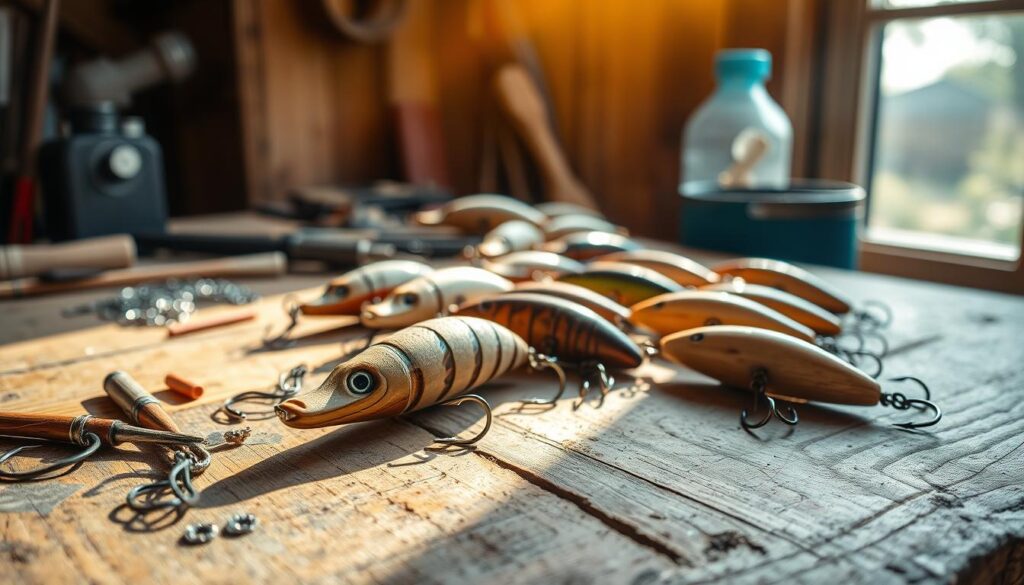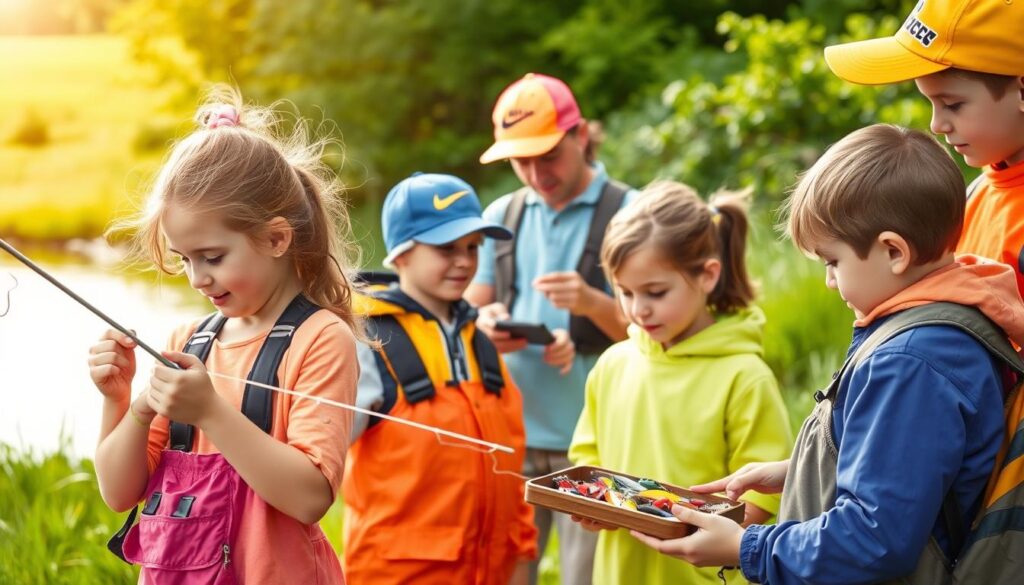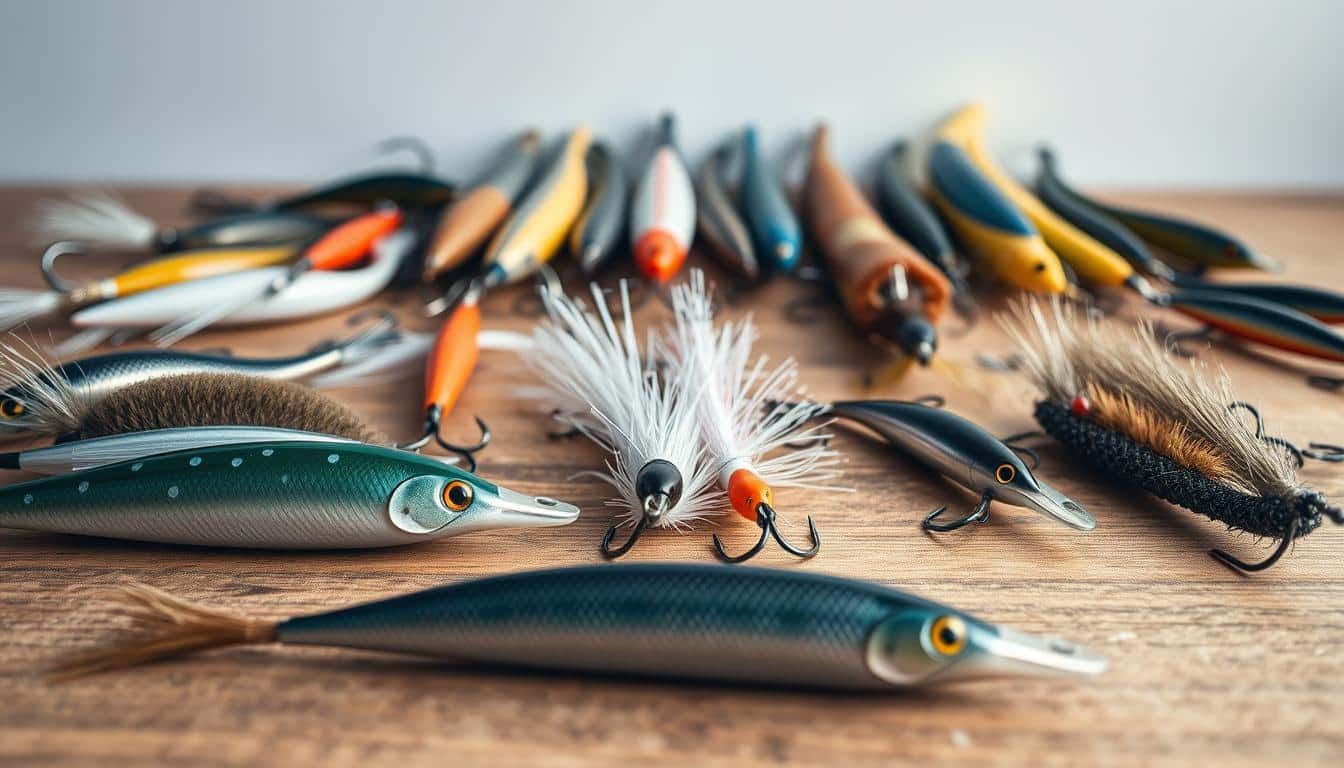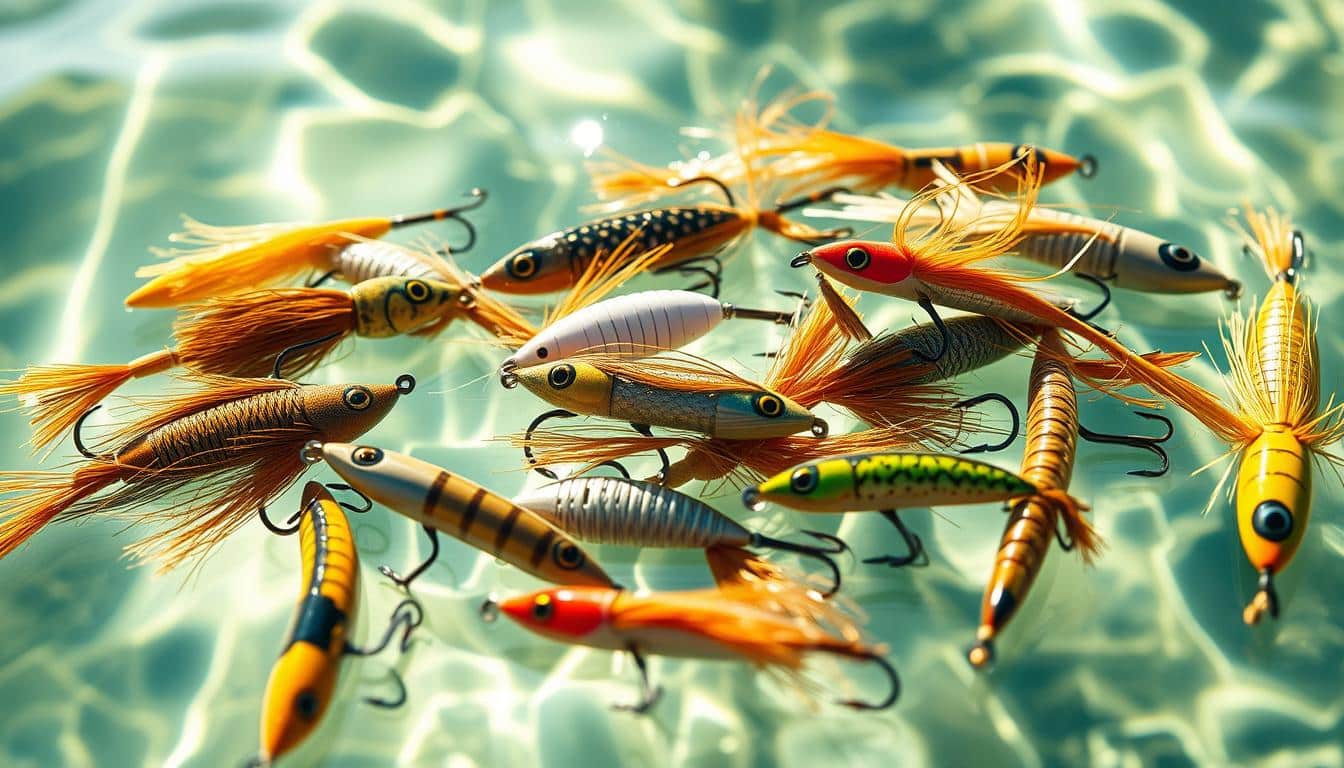This piece guides U.S. families on choosing plastic-free lures for kids. It shares tips on finding eco-friendly fishing gear. This makes fishing safe for kids while helping protect our lakes and rivers.
We talk about what non-plastic fishing lures are. We cover materials like wood, cork, metal, and biodegradable stuff. You’ll learn about safety, picking the right gear for kids, and fun DIY projects to teach sustainable fishing.
Some key points we mention are brands like Rapala wooden plugs and Mustad hooks. We also share resources from the EPA, Trout Unlimited, and Keep America Beautiful to help with eco-fishing. Later, we’ll look at how to care for gear, compare costs, and find local groups for learning together.
Why Choose Plastic-Free Fishing Gear for Children
Opting for plastic-free fishing gear for young anglers mixes safety, learning, and eco-friendliness. Parents and coaches prefer natural baits and simple spoons. This reduces stress during fishing trips. Kids learn valuable lessons while adults show them how to care for our planet.
Kids can get hurt by sharp or broken plastic pieces. Tiny parts may pose a choking risk for the little ones. Also, certain soft plastics might have harmful additives. Switching to wood, cork, or metal lures means fewer breaks and less risk of sharp pieces.
Plastic lures that get lost or break down pollute our lakes and rivers. They turn into microplastics that stick around in the environment. By choosing better options, we help lower this pollution. This makes life better for fish and keeps our waters clean.
Teaching kids to look after their gear is important. Cleaning, fixing, and storing their gear properly teaches them to be responsible. These activities help kids appreciate nature more. They learn to respect wild areas.
- Environmental benefits: Less plastic trash in our waters, fewer microplastics.
- Safety gains: Reduces dangers like choking and harmful chemicals.
- Educational value: Kids learn about how to take care of materials. They also learn how to fix things and protect nature.
Groups like Trout Unlimited offer programs for youth that focus on these important messages. When families choose gear without plastic, they support healthy fish homes. This also promotes better health for children who fish.
Understanding Materials: Natural and Biodegradable Lure Options
Picking the right gear matters for young anglers. This guide looks at natural and biodegradable lures. It explores their pros and cons for family trips.
Common natural materials used in lures (wood, cork, metal)
Wood, like balsa and cedar, floats well and is great for bass and trout. Rapala and other brands have made wood lures a classic pick.
Cork is light and stays afloat, making it perfect for floats and light lures. It’s also easy for kids and DIY projects.
Metal gives lures weight and shine, with brands like Mustad offering durable options. It’s a solid choice for young anglers.
Biodegradable polymers and safe coatings
New, eco-friendly materials like PLA are now used in fishing gear. They’re mainly for calm, freshwater spots.
Safe finishes, like marine varnish, keep wood and cork lures lasting longer. They make gear safe for kids and the environment.
Always check labels and data sheets to ensure materials are non-toxic and child-friendly.
Comparing durability and performance
Metal lures are tough and fly far. Wood lures are easy to fix and move well in water. This helps families find the right lures for their spot.
Biodegradable options are good for quiet waters but not for rough, salty places. They can’t handle as much wear and tear.
- Wood: customizable, repairable, needs to be recoated.
- Cork: floaty and light, must be sealed over time.
- Metal: strong and shiny, great for casting.
It’s crucial for parents to consider upkeep and the fishing environment. Eco-friendly lures can lessen plastic waste and still perform well for young fishers.
Plastic-Free Lures for Kids: Safe and Sustainable
Choosing gear without petroleum-based plastics protects our waters. It also makes fishing safe for young anglers. Look for clear materials listings, metal details, and natural finishes.
Parents deserve to know what’s in the products. Packaging and descriptions should be clear about being truly plastic-free.
What makes a lure truly plastic-free
A lure is truly plastic-free if it avoids materials like nylon or PVC. It should not have petroleum-based plastics in its body, parts, or coatings. Look for metal hooks and rings, and finishes free of plasticizers.
The plastic-free promise should also cover packaging and all parts of the product. Only then is it truly plastic-free.
Examples of certified or labeled plastic-free products
- Wooden plugs and spoons must have a wood core, metal parts, and natural varnish.
- Metal spoons and spinners by brands like Mepps or Abu Garcia should use minimal plastic in their packaging.
- Cork bobbers and floats are often found in specialty shops. They focus on traditional, less harmful materials.
How to verify materials and manufacturer claims
- Always read the full list of materials. Ask for more info if you’re unsure.
- Look for eco-certifications like FSC for wood, and check for safety with RoHS or REACH.
- Reach out to brands or shops directly. Also, read reviews from reliable sources to ensure products are eco-friendly and durable.
For shopping, search for terms like truly plastic-free lures. Ask sellers about eco-friendly options. Be wary of vague claims that can’t be backed up.
Top Plastic-Free Lures and Brands Recommended for Families
Choosing good gear makes the first fishing trip fun and safe for kids. This guide highlights beginner picks, trusted makers, and where parents in the United States can find quality, sustainable tackle. It gives brief notes on each option to fit kids’ ages and local waters.
Beginner-friendly wooden plugs and spoons
- Classic wooden poppers and small plugs are great for ponds and small lakes. They catch panfish and bass well. Look for smooth edges, sturdy metal hardware, and a waterproof finish.
- Metal spoons (sizes 00–2) and small Mepps spinners attract fish well. They’re easy to throw and bring back. This helps kids learn quickly how to hook and reel in fish.
- Check the finish and hardware when shopping. Proper sealing keeps the wood from swelling. If materials are listed, ask about the use of low-VOC varnish.
Eco-conscious brands with kid-safe designs
- Rapala is known for high-quality wooden models and carved lures perfect for family trips.
- Small artisans like Trianon and certain Etsy sellers provide good finishes and single-hook options. Look for those who mention using responsibly sourced wood and FSC certification.
- These eco-friendly fishing brands often use recyclable or compostable packaging. They also try to use less plastic in their products.
Where to buy: local shops and reputable online retailers
- Local bait and tackle shops let you see lures firsthand and offer expert advice. They usually have the best plastic-free lures for the area’s waters.
- Big stores and speciality shops like Bass Pro Shops, Cabela’s, and TackleDirect show product details and return policies online. You can find plastic-free lures from the USA on their websites or directly from the makers.
- Online craft markets and makerspaces have unique wooden plugs for kids. Make sure to check reviews, ask about materials, and confirm the type of finish before you buy.
Start with simple, long-lasting lures and basic safety gear. Teach kids how to be safe with hooks. A few good choices from environmentally friendly brands can make fishing safer and more sustainable for families.
Teaching Kids to Fish Responsibly with Plastic-Free Gear
Teaching young anglers to love fishing and protect our waters and wildlife creates lasting habits. Starting with simple rules that mix safety and care for the environment. This way, parents and youth leaders can feel sure by the water.
Safety lessons: hooks, casting distance, and supervision
Start by teaching the basics of how to cast safely. Make sure kids look behind before casting and keep space around them. Use rigs with single hooks or without barbs to lessen the chance of getting hurt and ease hook removal.
Show them the right way to handle hooks. Use pliers for taking hooks out and never let kids handle sharp hooks alone. Choose hooks and rods that are safe for their age to prevent accidents.
Always watch kids near water. Whether boating or wading, follow the U.S. Coast Guard’s rules for life jackets and stay alert with young fishers. These steps make fishing safer for kids and let families focus on learning and fun.
Conservation education while fishing
Teach them to catch and release fish the right way from the start. They should wet their hands before touching fish, remove hooks fast, and cut down the time fish are out of water. Show them how to let fish go gently so the fish populations stay strong.
Discuss the fish in the area and the rules from fish and wildlife agencies. Talk about how to stop invasive species and why cleaning gear between water bodies is crucial. Use these times to talk about why using gear without plastic is better for the environment and safer from chemicals.
Activities to reinforce stewardship (cleanup, ID guides)
Set up activities that combine learning with action. Organize cleanups along the shore or get involved with groups like Keep America Beautiful to make cleanups a regular part of fishing.
- Bring along simple guides for identifying fish and bugs. Let kids log what they see to learn about species and their homes.
- Keep a journal for gear to track lost items and fixes. Share this info with local groups to aid their efforts.
- Make wooden lures as a project that teaches crafting and cuts down on waste.
By taking these steps, kids learn to fish in a safe and caring way. Parents and mentors who mix safety with learning about conservation give kids valuable outdoor experiences. They help protect our waters for the anglers of the future.
DIY Plastic-Free Lures: Simple Projects for Kids and Parents
Making lures at home without plastic teaches kids about taking care of the environment. These projects are perfect for the weekend, mixing fun with learning. Just start with the basics and make sure your space is ready.

Easy wooden lure builds and painting tips
- Use balsa or cedar for their lightness and floatability.
- First, create small holes for the eye screws and cut a slot for the keel.
- When shaping with sandpaper, include kids. Adults should handle any knives and always wear glasses when drilling.
- Decorate with water-based paints for vibrant colors. Show kids how to use stencils for designs.
- Seal with a thin layer of marine-grade coating to protect without using plastic.
Using natural materials safely and effectively
- Choose eco-friendly wood like FSC-certified balsa or cedar.
- Cork is great for heads or floats and easy to shape.
- Stay away from treated woods to avoid toxins.
- Opt for stainless or nickel-plated hardware to prevent rust in any water.
- For safety, use non-toxic paints and finishes made for marine environments.
Steps for varnishing and maintaining DIY lures
- Start with cleaning the lure of any dust or grease.
- Apply several layers of marine-grade varnish, sanding lightly in between for stickiness.
- Wait for it to fully cure as instructed to keep water out and the finish intact.
- Check lures yearly. Fix any damage, update finishes as needed, and change rusty parts.
- Keep a repair kit ready with varnish, brushes, and spare parts for easy fixes.
By following these guidelines, families can make lasting wooden lures safely. This activity is not only enjoyable but also teaches kids the importance of maintenance and responsibility.
Maintenance and Care to Extend Lifespan of Non-Plastic Lures
Proper care keeps lures ready and saves money. Simple routines protect wood, metal, and natural finishes after each trip. These small steps prevent corrosion and keep action accurate.
Cleaning and drying routines after use
Rinse freshwater lures in clean water soon after fishing. For saltwater trips, rinse well to remove salt and prevent corrosion.
Make sure lures are completely dry before storing. Use a towel, then let them air dry in a well-ventilated place. This avoids warping. If possible, take off hooks and split rings to dry hard-to-reach spots.
Lightly oil moving parts with anti-corrosion oil like WD-40 Specialist Marine. This helps keep metal parts from getting stuck or rusty.
Repair techniques for chips, hooks, and finish wear
Sand small chips on wood smooth. Use marine-grade epoxy putty for deeper gouges. After it’s hard, sand and refinish with varnish to restore strength and look.
Change out rusty hooks and split rings quickly. Go for stainless steel or nickel-plated choices from trusted brands. This is how to repair lures without messing up their balance.
Be sparing with touch-up paint and finish. Use thin coats and let them cure fully to keep the lure performing well. Check how they move in water before taking them out fishing.
Proper storage to prevent damage and corrosion
Keep lures in breathable storage or on racks. Never store wet lures in airtight containers. Use silica gel in storage to soak up extra moisture.
For storage over long periods, remove hooks to reduce stress on wood. Keep wooden lures away from too much sun to prevent damage to the finish.
Regularly cleaning wooden and other non-plastic lures lessens repair needs. It also makes storing metal lures easier between fishing seasons.
Safety Guidelines and Age-Appropriate Gear for Young Anglers
Teaching kids to fish safely makes it way more fun and a lot less risky. Stick to simple rules, watch them closely, and pick fishing gear that fits their abilities. We’ll talk about the best ages for different gear, protective stuff to wear, and how to rig things safely. It’s all about keeping kids safe and boosting their confidence at the lake or river.

Recommended age ranges for different lure types
Little ones aged 3 to 5 do well with simple fishing setups. Think bobbers, worms for bait, and short rods. Always go for hooks without barbs and steer clear of tiny treble hooks or heavy lures.
Kids aged 6 to 9 can try out small spoons, wooden plugs with one hook, and spinners with safety caps. Show them how to cast and manage their line while you keep a close eye on them.
Once kids hit 10 and older, they might be ready for bigger metal spoons, wooden plugs, and fancier setups. Remember, these age suggestions are just a start. Make sure to see if they’re really ready.
Protective gear and supervision best practices
- Make sure kids wear PFDs approved by the U.S. Coast Guard when they’re near water or on a boat. The right fit is key, so check the label for the size and weight it’s meant for.
- Wearing glasses to protect eyes and closed-toe shoes to keep feet safe from hooks is a smart move.
- One grown-up should be there for each kid until you’re sure they’ve got the safety rules down. Have clear rules about handling hooks, bait, and how far to cast.
Choosing hook sizes and rigging for safety
Go for hooks without barbs or press down the barbs with pliers. This makes them less dangerous and easier to get out. Choose hook sizes that match the fish you’re after; smaller hooks are better for smaller fish since they’re less likely to swallow the hook deep.
Single hooks are better than treble hooks for kids’ lures. Swapping out treble hooks for single ones is safer and makes letting fish go easier, if that’s allowed where you’re fishing.
Have a hook size chart that’s easy for kids to get. Mark tackle boxes with the right sizes and setups for different ages. This helps grown-ups pick the right gear and cuts down on accidents.
Cost Comparison: Long-Term Value of Plastic-Free vs Plastic Lures
When picking lures for fishing with family, you must look at the initial price and what they’re worth over time. High-quality wooden plugs and metal spoons cost more at first than soft plastics. Yet, a wooden lure offers a special look, feel, and tradition, which many fishers love.
Creating lures yourself saves money upfront and teaches kids valuable lessons. Spending a weekend crafting a wooden spoon can make eco-friendly lures more affordable. Plus, it’s a chance to learn how to repair items. Soft plastics might seem cheaper by the pack, but needing new ones often increases costs.
Initial costs and perceived value
- Wooden or metal lures have a higher price but feel more valuable.
- Soft plastics are cheaper but need to be replaced more often.
- DIY lures cost little and bring families together through learning.
Longevity, repairability, and lifecycle costs
Wood and metal lures can be fixed. By refinishing wood or replacing hooks, they last longer. This makes them more cost-effective per season. However, soft plastics usually cannot be repaired and are often thrown away after one use.
- Fixing lures means buying fewer new ones and less trash.
- Refreshing or fixing parts on wooden lures makes them last longer.
- Think about disposal: plastic lures stay in landfills and waterways longer, while wood and metal have different ends.
Environmental cost savings and community benefits
Using fewer plastics helps keep parks and harbors clean. Towns that use eco-friendly fishing gear see less pollution and spend less on maintenance. Plus, clean fishing spots attract tourists, saving money and keeping places beautiful.
Supporting local businesses and eco-friendly products keeps money nearby and encourages better gear. This push towards repairing and learning helps families make wiser choices. Eventually, it’s clear that wooden lures are better for both wallets and the environment than plastic ones.
Considering the savings from not buying as many lures and the wider community benefits, eco-friendly fishing gear often comes out ahead financially. These savings influence how fishers and communities think about sustainable fishing for the future.
Where to Find Resources and Community Support in the United States
Joining local groups and online networks is key to finding gear, classes, and events for kids. These places focus on safe, low-impact fishing. They offer things like hands-on learning, volunteer work, and family meetups, all about protecting nature and building skills.
Local fishing clubs and youth programs have events that are free or cheap. Check out state agencies, like the California Department of Fish and Wildlife or the New York DEC. There are also national programs like Recreational Boating & Fishing Foundation’s Take Me Fishing. Trout Unlimited chapters and park departments organize family days focusing on eco-friendly practices.
- Contact state fish and wildlife offices for regional youth fishing program calendars.
- Look at community centers, libraries, and parks for youth fishing events that are good for the environment.
- Organizations like Big Brothers Big Sisters and local nonprofits often have fishing days with a focus on mentorship and low-impact gear.
Makerspaces and public woodshops are great for teaching kids to make lures safely. Community colleges and libraries offer workshops on woodworking and safety with hooks. Conservation groups work with these places on projects to help habitats and recycle fishing gear.
- Look for lure-making classes at libraries or community colleges.
- Get involved with watershed councils or Keep America Beautiful for cleanup events.
- Help with stream restorations to learn about conservation from experienced anglers.
Online resources help you exchange tips, find suppliers, and watch how-to videos. Magazines like Field & Stream and In-Fisherman give advice on fishing sustainably. Social media has active groups for families to share projects and find local gatherings.
- Look for eco-friendly fishing communities online for gear swaps and forums focused on families.
- Watch YouTube for kid-friendly lure making and safety tips. Make sure the creators are reliable and clear about safety.
- Find Facebook groups and subreddits focused on fishing for kids and eco-friendly tackle to share ideas and event info.
Mixing real-life programs with online groups supports families interested in plastic-free fishing gear. Getting involved with fishing clubs in the USA and lure-making workshops teaches practical skills. Following online communities helps families stay informed about events, product tips, and conservation efforts.
Conclusion
Choosing to use plastic-free lures can help make our waters cleaner. It also lessens the danger of microplastics. Plus, it teaches kids the importance of caring for nature. Using things like simple wood plugs, metal spoons, and cork baits works well. They also reduce harm to the environment. This makes fishing with family both fun and good for the planet.
Make sure to pick the right size hook for each kid. Always watch them closely when they’re fishing. And don’t forget life jackets. Cleaning and maintaining your gear is key. Rinse, dry, and fix them up to make them last longer. Getting into DIY lure projects can also be a great way to learn. It also helps kids feel closer to nature.
Look for trustworthy fishing gear at local shops. Joining youth fishing programs or conservation groups is a good idea too. They can offer the right guidance. It’s also smart to check what gear is made of. This way, you make sure you’re picking eco-friendly options. For families across the U.S., adopting these fishing practices can lessen plastic waste. It keeps fishing enjoyable and safe for everyone.
FAQ
What are plastic-free lures and why choose them for kids?
Which materials are safest and most effective for children’s lures?
Are metal spoons and spinners appropriate for young anglers?
What age is appropriate for using wooden or metal lures?
How do I verify a product is truly plastic-free?
Are biodegradable polymer lures a reliable alternative?
Can I make safe DIY wooden lures with my child?
How should I finish and maintain DIY or wooden lures?
What safety practices should parents teach before casting?
How do I reduce corrosion on metal lures and hardware?
Where can I buy reputable plastic-free or low-plastic lures?
How do plastic-free lures compare in cost to soft plastics?
What steps should families take to practice responsible angling with plastic-free gear?
Are there certifications or labels I should look for on eco-friendly lures?
What are quick repair tips for chipped wooden lures?
How can I involve local resources and communities in learning about plastic-free gear?
Content created with the help of Artificial Intelligence.



